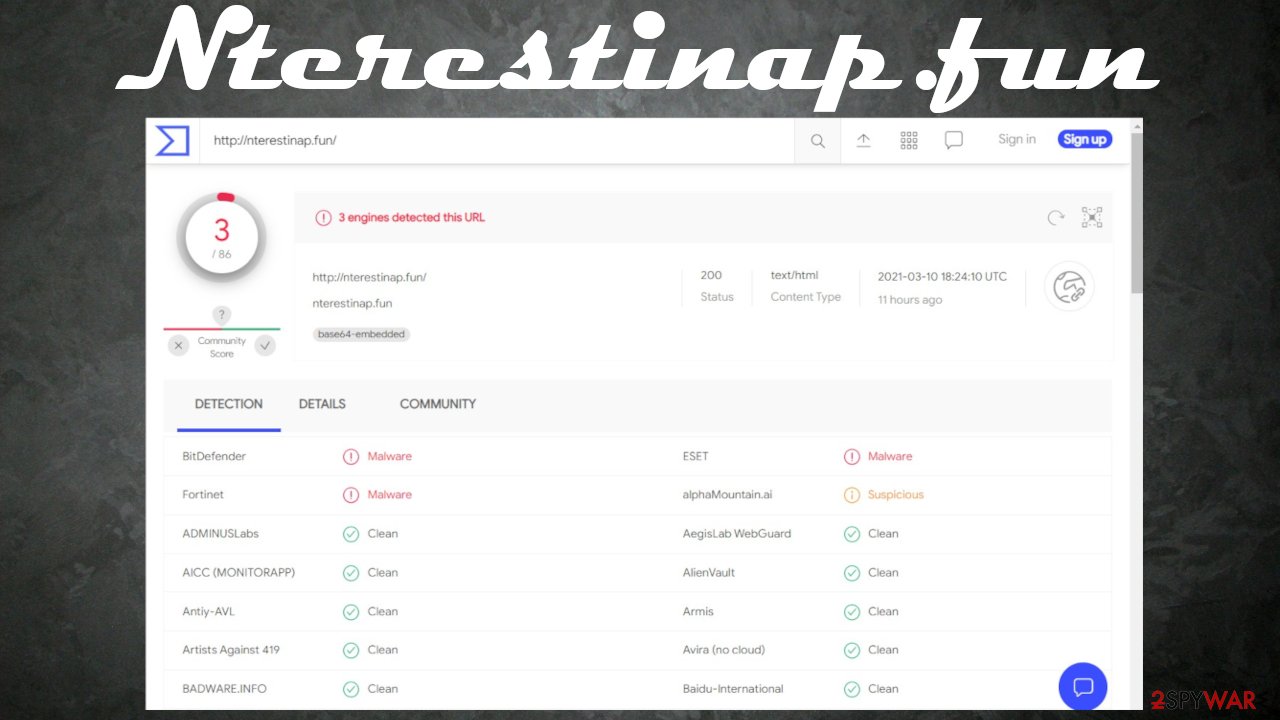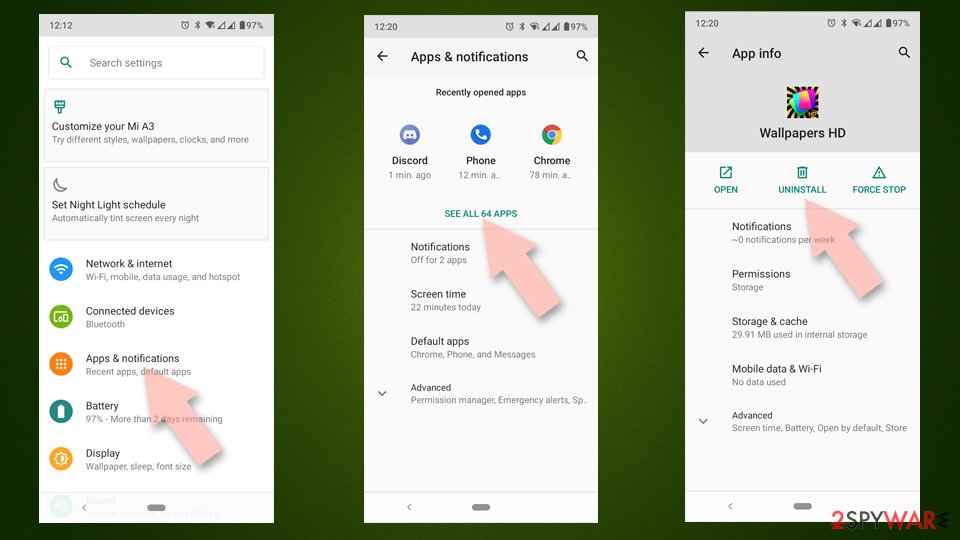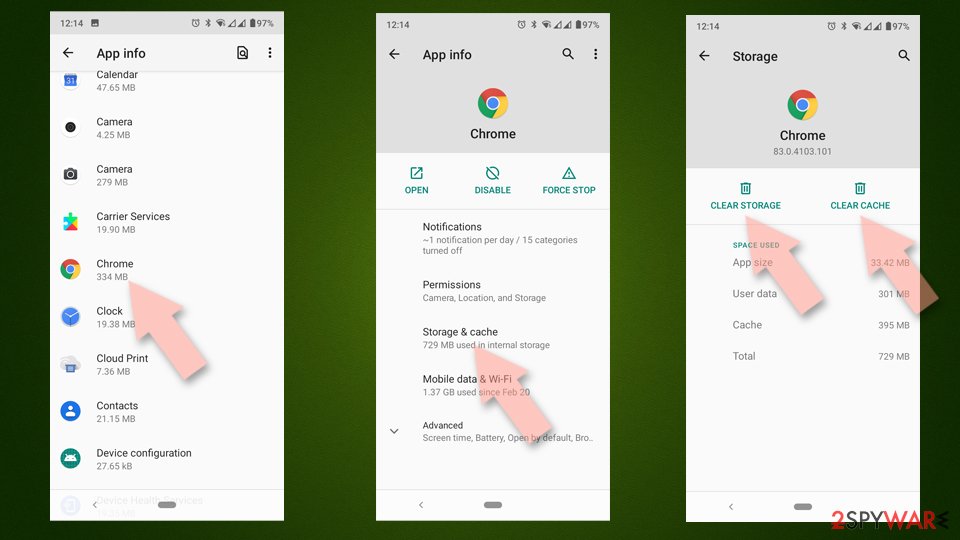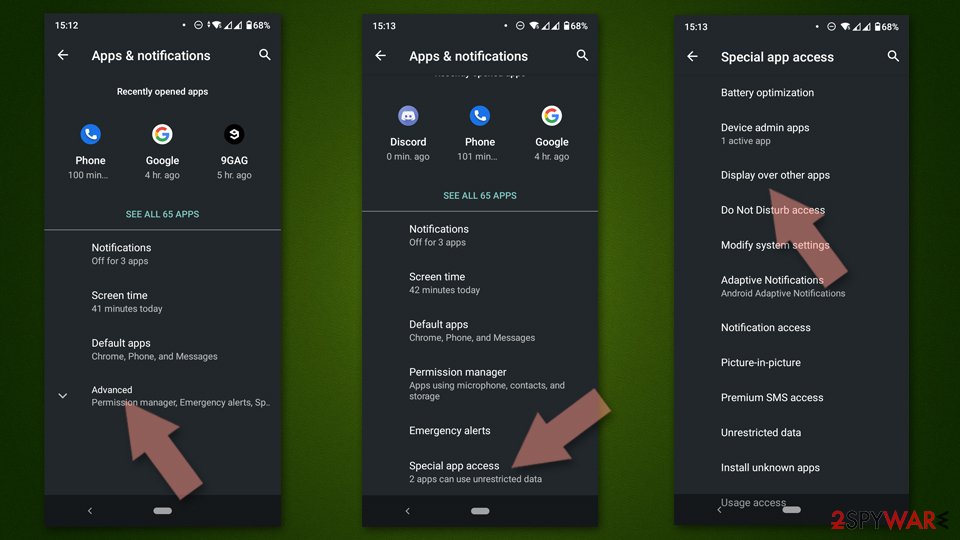Nterestinap.fun (Simple Removal Guide) - Chrome, Firefox, IE, Edge
Nterestinap.fun Removal Guide
What is Nterestinap.fun?
Nterestinap.fun – an insidious website trying to trick you to accepts its misleading apps

Nterestinap.fun is a push notification virus website that can show you different prompts to deceive you into subscribing to its alerts. It can ask you to click the Allow button to continue watching a video, enter the site, verify that you're over 18 years old, reveal hidden content, etc. If you didn't enter this address willingly, but this site keeps on opening, you have an adware infection. Whatever the case may be, please don't enable its notifications.
Nterestinap.fun ads are shown in the form of notifications, and they can be delivered directly to your computer desktop or phone screen. They are deemed deceptive because if any of them are clicked, you will be redirected to a portal with nothing in common with the ad itself.
Adware is classified as a potentially unwanted program[1] (PUP) thus shouldn't be used by anyone. One PUP infection can attract other ones. By reading this article, you'll understand how these intruders function, how they're distributed, the risks of having them, and of course, their removal and recovery options.
| name | Nterestinap.fun |
|---|---|
| Type | PUP, adware, redirect virus |
| IP address | 52.206.71.220 |
| Purpose | Trick people into enabling push notifications to show deceptive ads and redirect to affiliated sites |
| Symptoms | Sudden redirects, ads shown as notifications in top-right or bottom-right corners, internet problems, device lag |
| Risks | Sponsored sites might have malicious intentions, thus user might be exposed to scams, malware, and other threats |
| Distribution | Fake Flash Player updates, deceptive ads, freeware bundles, torrent platforms |
| Removal | If you see any symptoms, please scan your device with a trustworthy anti-malware tool to eliminate any possible cyber threats |
| System Health | To restore your device to a pre-contamination phase, by removing tracking cookies and repairing system directories/settings, use the all-in-one FortectIntego system tune-up tool |
Push notifications are a legitimate feature that most websites use to inform their subscribers of the latest news, awesome software or hardware deals, and so on. But cyber criminals started exploiting this feature for their own gain. Using various deception methods, they trick people into clicking the Allow button and then deliver them ads of affiliated sites.
And since no PUP developer ever cared about their users' safety, that's where things could get risky. If you click on Nterestinap.fun ads, you might end up on any portal that paid the most to advertise itself. Thus you could end up on websites like:
- gambling,
- porn,
- malware,
- fake updates,
- other push notification viruses, etc.
Furthermore, Nterestinap.fun redirect could land you on any of these pages without you even clicking on any ads. To be fair, not all of those sites might be harmful, but some could seek to steal your private information (SSNs, credit card details, addresses, phone numbers, etc.), infect your devices with malware through drive-by downloads,[2] install other PUPs, and so on.
Nterestinap.fun virus is one of mane push notification sites including Maxcooper.club virus, Itscythera.com virus, Club-news.xyz virus, developed to deceive people into believing that they're visiting a legitimate website and that nothing wrong will happen if the Allow button is clicked.

Such sites and adware could bring only harm both to you and your device. So please scan your device with a trustworthy security tool to remove Nterestinap.fun and any adware, other PUPs, or malware. If you think your AV tool isn't enough for this task, we recommend using free anti-malware solutions such as SpyHunter 5Combo Cleaner or Malwarebytes.
Nterestinap.fun removal must be finished off by running system diagnostics with proper tools to delete any of its traces from system directories, settings, and other core system items. IT experts[3] highly recommend using the FortectIntego system repair tool for this as it will also clean up your device from junk files, including tracking cookies.
Prevent adware and other PUPs by paying attention when installing new software
People rarely install potentially unwanted programs, like unwanted toolbars, browser hijackers, adware, and others willingly. They're either tricked into it or install it unknowingly. Most of the time, the latter option happens when they rush through the installation of new software.
PUP developers use a sneaky method to distribute their creations. It's called software bundling and they are usually downloaded from third-party program vendors. The trick is that all apps within a bundle are preselected for installation. Thus there are two ways to avoid PUP spread this way.
Either download all your apps directly from their developers (although that doesn't guarantee that PUPs won't be hidden within the installation) or stay cautious when installing new software. Please don't rush and choose the Advanced or Custom modes and deselect all untrustworthy, unwanted apps from installing on your device.
In addition, please don't believe ads on shady websites claiming that you need to update your Flash Player or that some app will increase your device performance or browsing experience tenfold. These are attempts to trick you into downloading PUP or even malware.

Simple instructions to safely remove Nterestinap.fun with all of its components
Falsely advertised Nterestinap.fun virus could only endanger you by exposing you to explicit, insidious, or even malicious websites. If you're not careful, when this cyber infection is on your device, it might be soon overrun by potentially unwanted programs, or even worse – malware.
Thus you should perform Nterestinap.fun removal ASAP. To do that automatically, download a reliable anti-malware tool and initiate a full system scan. Proper security software should detect, isolate, and eliminate any PUPs, malware, and suspicious files.
If you subscribed to the website's alerts, you need to remove Nterestinap.fun notifications from your browsers. Below we've posted our free guide to do that from any browser, including Safari, Chrome, etc. Afterward, run a system tune-up with compatible tools to prevent any abnormal device behavior by resolving system irregularities.
You may remove virus damage with a help of FortectIntego. SpyHunter 5Combo Cleaner and Malwarebytes are recommended to detect potentially unwanted programs and viruses with all their files and registry entries that are related to them.
Getting rid of Nterestinap.fun. Follow these steps
Stop browser notifications
Remove unwanted notifications from Google Chrome (desktop):
- Open Google Chrome browser and go to Menu > Settings.
- Scroll down and click on Advanced.
- Locate Privacy and security section and pick Site Settings > Notifications.

- Look at the Allow section and look for a suspicious URL.
- Click the three vertical dots next to it and pick Block. This should remove unwanted notifications from Google Chrome.

Remove unwanted notifications from Google Chrome (Android):
- Open Google Chrome and tap on Settings (three vertical dots).
- Select Notifications.
- Scroll down to the Sites section.
- Locate the unwanted URL and toggle the button to the left (Off setting).

Remove unwanted notifications from Mozilla Firefox:
- Open Mozilla Firefox and go to Menu > Options.
- Click on Privacy & Security section.
- Under Permissions, you should be able to see Notifications. Click the Settings button next to it.

- In the Settings – Notification Permissions window, click on the drop-down menu by the URL in question.
- Select Block and then click on Save Changes. This should remove unwanted notifications from Mozilla Firefox.

Remove unwanted notifications from Safari:
- Click on Safari > Preferences…
- Go to the Websites tab and, under General, select Notifications.
- Select the web address in question, click the drop-down menu and select Deny.

Remove unwanted notifications from MS Edge:
- Open Microsoft Edge, and click the Settings and more button (three horizontal dots) at the top-right of the window.
- Select Settings and then go to Advanced.
- Under Website permissions, pick Manage permissions and select the URL in question.

- Toggle the switch to the left to turn notifications off on Microsoft Edge.

Remove unwanted notifications from MS Edge (Chromium):
- Open Microsoft Edge, and go to Settings.
- Select Site permissions.
- Go to Notifications on the right.
- Under Allow, you will find the unwanted entry.
- Click on More actions and select Block.

Remove unwanted notifications from Internet Explorer:
- Open Internet Explorer, and click on the Gear icon at the top-right of the window.
- Select Internet options and go to the Privacy tab.
- In the Pop-up Blocker section, click on Settings.
- Locate web address in question under Allowed sites and pick Remove.

Uninstall from Windows
Instructions for Windows 10/8 machines:
- Enter Control Panel into Windows search box and hit Enter or click on the search result.
- Under Programs, select Uninstall a program.

- From the list, find the entry of the suspicious program.
- Right-click on the application and select Uninstall.
- If User Account Control shows up, click Yes.
- Wait till uninstallation process is complete and click OK.

If you are Windows 7/XP user, proceed with the following instructions:
- Click on Windows Start > Control Panel located on the right pane (if you are Windows XP user, click on Add/Remove Programs).
- In Control Panel, select Programs > Uninstall a program.

- Pick the unwanted application by clicking on it once.
- At the top, click Uninstall/Change.
- In the confirmation prompt, pick Yes.
- Click OK once the removal process is finished.
Delete from macOS
Remove items from Applications folder:
- From the menu bar, select Go > Applications.
- In the Applications folder, look for all related entries.
- Click on the app and drag it to Trash (or right-click and pick Move to Trash)

To fully remove an unwanted app, you need to access Application Support, LaunchAgents, and LaunchDaemons folders and delete relevant files:
- Select Go > Go to Folder.
- Enter /Library/Application Support and click Go or press Enter.
- In the Application Support folder, look for any dubious entries and then delete them.
- Now enter /Library/LaunchAgents and /Library/LaunchDaemons folders the same way and terminate all the related .plist files.

Uninstall from Android
Uninstall unwanted programs from Android device:
- Go to Settings -> Apps/Applications.
- Expand the full list of the installed apps.
- Scroll through the list and tap on a suspicious application once.
- Tap on it and select Uninstall.

- Reboot the device.
Clear Storage and data files on Android from Google Chrome or other apps:
- Go to Settings > Apps/Applications.
- Expand the full list of the installed apps.
- Tap on Chrome and select Storage & cache.
- Clear storage and clear cache of the app.

If you are seeing ads on top of other apps but are not sure what is causing it, perform the following steps:
- Go to Apps/Applications.
- Tap Advanced.
- Select Special App access.
- Tap on Display over other apps.

- Eliminate apps with these access rights enabled.
Remove from Microsoft Edge
Delete unwanted extensions from MS Edge:
- Select Menu (three horizontal dots at the top-right of the browser window) and pick Extensions.
- From the list, pick the extension and click on the Gear icon.
- Click on Uninstall at the bottom.

Clear cookies and other browser data:
- Click on the Menu (three horizontal dots at the top-right of the browser window) and select Privacy & security.
- Under Clear browsing data, pick Choose what to clear.
- Select everything (apart from passwords, although you might want to include Media licenses as well, if applicable) and click on Clear.

Restore new tab and homepage settings:
- Click the menu icon and choose Settings.
- Then find On startup section.
- Click Disable if you found any suspicious domain.
Reset MS Edge if the above steps did not work:
- Press on Ctrl + Shift + Esc to open Task Manager.
- Click on More details arrow at the bottom of the window.
- Select Details tab.
- Now scroll down and locate every entry with Microsoft Edge name in it. Right-click on each of them and select End Task to stop MS Edge from running.

If this solution failed to help you, you need to use an advanced Edge reset method. Note that you need to backup your data before proceeding.
- Find the following folder on your computer: C:\\Users\\%username%\\AppData\\Local\\Packages\\Microsoft.MicrosoftEdge_8wekyb3d8bbwe.
- Press Ctrl + A on your keyboard to select all folders.
- Right-click on them and pick Delete

- Now right-click on the Start button and pick Windows PowerShell (Admin).
- When the new window opens, copy and paste the following command, and then press Enter:
Get-AppXPackage -AllUsers -Name Microsoft.MicrosoftEdge | Foreach {Add-AppxPackage -DisableDevelopmentMode -Register “$($_.InstallLocation)\\AppXManifest.xml” -Verbose

Instructions for Chromium-based Edge
Delete extensions from MS Edge (Chromium):
- Open Edge and click select Settings > Extensions.
- Delete unwanted extensions by clicking Remove.

Clear cache and site data:
- Click on Menu and go to Settings.
- Select Privacy, search and services.
- Under Clear browsing data, pick Choose what to clear.
- Under Time range, pick All time.
- Select Clear now.

Reset Chromium-based MS Edge:
- Click on Menu and select Settings.
- On the left side, pick Reset settings.
- Select Restore settings to their default values.
- Confirm with Reset.

Remove from Mozilla Firefox (FF)
Remove dangerous extensions:
- Open Mozilla Firefox browser and click on the Menu (three horizontal lines at the top-right of the window).
- Select Add-ons.
- In here, select unwanted plugin and click Remove.

Reset the homepage:
- Click three horizontal lines at the top right corner to open the menu.
- Choose Options.
- Under Home options, enter your preferred site that will open every time you newly open the Mozilla Firefox.
Clear cookies and site data:
- Click Menu and pick Settings.
- Go to Privacy & Security section.
- Scroll down to locate Cookies and Site Data.
- Click on Clear Data…
- Select Cookies and Site Data, as well as Cached Web Content and press Clear.

Reset Mozilla Firefox
If clearing the browser as explained above did not help, reset Mozilla Firefox:
- Open Mozilla Firefox browser and click the Menu.
- Go to Help and then choose Troubleshooting Information.

- Under Give Firefox a tune up section, click on Refresh Firefox…
- Once the pop-up shows up, confirm the action by pressing on Refresh Firefox.

Remove from Google Chrome
Delete malicious extensions from Google Chrome:
- Open Google Chrome, click on the Menu (three vertical dots at the top-right corner) and select More tools > Extensions.
- In the newly opened window, you will see all the installed extensions. Uninstall all the suspicious plugins that might be related to the unwanted program by clicking Remove.

Clear cache and web data from Chrome:
- Click on Menu and pick Settings.
- Under Privacy and security, select Clear browsing data.
- Select Browsing history, Cookies and other site data, as well as Cached images and files.
- Click Clear data.

Change your homepage:
- Click menu and choose Settings.
- Look for a suspicious site in the On startup section.
- Click on Open a specific or set of pages and click on three dots to find the Remove option.
Reset Google Chrome:
If the previous methods did not help you, reset Google Chrome to eliminate all the unwanted components:
- Click on Menu and select Settings.
- In the Settings, scroll down and click Advanced.
- Scroll down and locate Reset and clean up section.
- Now click Restore settings to their original defaults.
- Confirm with Reset settings.

Delete from Safari
Remove unwanted extensions from Safari:
- Click Safari > Preferences…
- In the new window, pick Extensions.
- Select the unwanted extension and select Uninstall.

Clear cookies and other website data from Safari:
- Click Safari > Clear History…
- From the drop-down menu under Clear, pick all history.
- Confirm with Clear History.

Reset Safari if the above-mentioned steps did not help you:
- Click Safari > Preferences…
- Go to Advanced tab.
- Tick the Show Develop menu in menu bar.
- From the menu bar, click Develop, and then select Empty Caches.

After uninstalling this potentially unwanted program (PUP) and fixing each of your web browsers, we recommend you to scan your PC system with a reputable anti-spyware. This will help you to get rid of Nterestinap.fun registry traces and will also identify related parasites or possible malware infections on your computer. For that you can use our top-rated malware remover: FortectIntego, SpyHunter 5Combo Cleaner or Malwarebytes.
How to prevent from getting adware
Stream videos without limitations, no matter where you are
There are multiple parties that could find out almost anything about you by checking your online activity. While this is highly unlikely, advertisers and tech companies are constantly tracking you online. The first step to privacy should be a secure browser that focuses on tracker reduction to a minimum.
Even if you employ a secure browser, you will not be able to access websites that are restricted due to local government laws or other reasons. In other words, you may not be able to stream Disney+ or US-based Netflix in some countries. To bypass these restrictions, you can employ a powerful Private Internet Access VPN, which provides dedicated servers for torrenting and streaming, not slowing you down in the process.
Data backups are important – recover your lost files
Ransomware is one of the biggest threats to personal data. Once it is executed on a machine, it launches a sophisticated encryption algorithm that locks all your files, although it does not destroy them. The most common misconception is that anti-malware software can return files to their previous states. This is not true, however, and data remains locked after the malicious payload is deleted.
While regular data backups are the only secure method to recover your files after a ransomware attack, tools such as Data Recovery Pro can also be effective and restore at least some of your lost data.
- ^ Potentially unwanted program. Wikipedia. The free encyclopedia.
- ^ Drive-By Download. Techopedia. Professional it insights.
- ^ Virukset. Virukset. Spyware news and security.




































